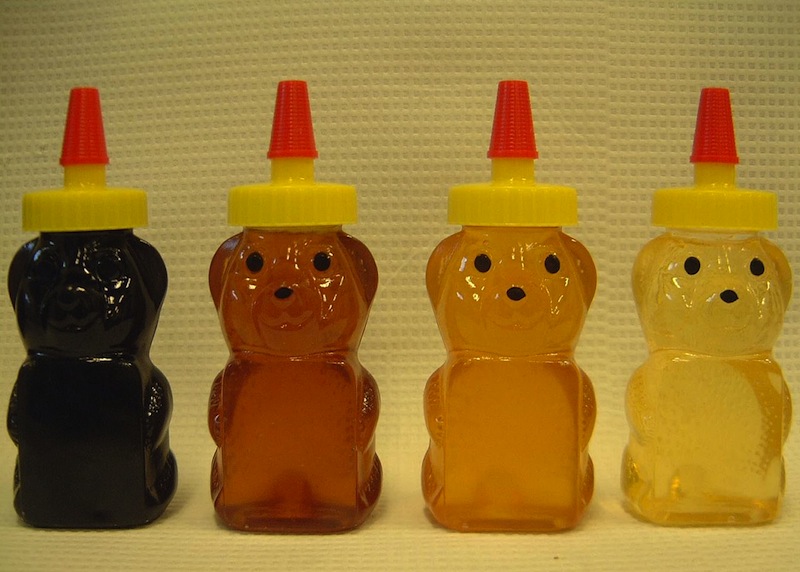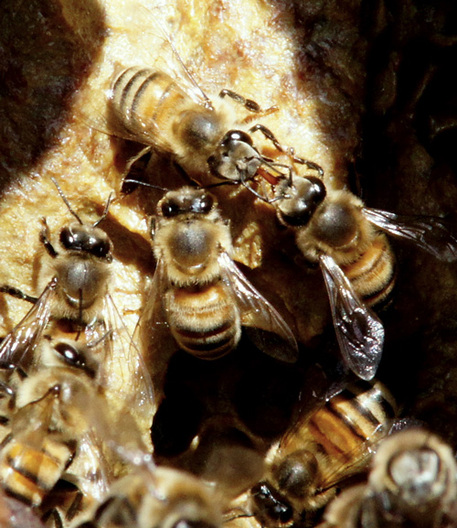Honey has been used throughout history and is now farmed all over the world. Bees play a key part in the ecosystem. Use honey sparingly, enjoying its health-promoting antimicrobial and antioxidant properties, and thank the hard-working bees (and local farmers) who brought it to you.
A brief history of honey
It’s the year 1702. You want to eat something sweet. What are your options? Can you hit up Whole Foods for xylitol or agave? Nope. You don’t even have table sugar. But if you’re lucky, and it’s the right time of year, you might get a little bit of honey.
Honey has been humans’ main sweetener for thousands of years. People didn’t really have sugar until intercontinental trade in the 18th century made cane sugar available.
Honeybees, which originated in Africa, have probably been around for 100 million years. So it’s no surprise that nearly every world culture uses honey.
For instance:
- Honey appears in Spanish cave paintings about 10-15,000 years old (see image below).
- Honey is part of Buddhist rituals and traditional Indian and Chinese medicine.
- Honey is mentioned often in the Jewish Talmud (honeybees are not kosher, but honey is), the Old and New Testaments of the Bible, and the Koran. In fact, the word honey appears 56 times in the King James version of the Bible; Biblical references to “the land of milk and honey,” probably refer to Tel Rehov, one of the most important cities in Israel and a beekeeping center.
- Bees and honey appear in Egyptian hieroglyphics (see image below).
- Ancient Greeks revered honey. The Greek physician Hippocrates used honey to treat skin ailments, while the philosopher Aristotle thought honey was deposited from the atmosphere.
- Honey was used for mead – the first known alcoholic drink in mythology.
- Old Scandinavian texts, such as the Kalevala, the ancient Finnish epic poem, also refer to honey. The term honeymoon originated with the Norse practice of consuming large quantities of mead during the first month of a marriage. This practice was believed to ensure fertility during the lunar cycle.
In 1866 Franz von Hruschka invented the first device to extract honey from the honeycomb using centrifugal force (after watching milkmaids swinging buckets).
In modern times, honey is often used in Middle Eastern/Mediterranean, African, northern and southern European cuisine.


Americans now consume 156 pounds of added sweeteners per year. Roughly 1.3 pounds of that — or 0.8% — is honey. (Comparatively, China only consumes about 0.4 to 0.6 pounds per person per year.)
Things have changed.
35% of honey is consumed at home and in restaurants. 65% is purchased by the industry and used in processed foods/drinks: Honey is a preservative.
Honey types & variations
Comb honey is the purest, rawest form of honey. The beeswax is edible.
Raw honey often contains wax, pollen, and other bee parts.
Liquid honey is often pasteurized (which decreases the chance of crystallization), and the beeswax has been filtered out.
Chunk honey is liquid honey with chunks of honeycomb.
Dry honey is dehydrated, and can be sold as powder, flakes, granules, etc. Usually contains additives.
Creamed/whipped honey is intentionally crystallized to allow for spreading.
Organic honey must be produced without certain pesticides, insecticides, and herbicides. This is hard to control since bees can travel up to 2 miles from the hive to gather nectar and pollen. Only nontoxic paints can be used on the beehives and no medications can be used on the bees.
Fair trade honey: if you’re getting honey from small local farmers, this won’t be an issue. But if you are buying honey from outside the U.S., ensuring Fair Trade is important so beekeepers get proper compensation.
Single flower species honey comes from nectar gathered from a single flower (e.g. orange blossom or clover honey). This honey must contain at least 51% of the specific type of nectar to be labeled as such.
Honey is produced across the U.S., and there are over 300 varieties of American honey.
Natural honey is diverse. For instance:
- Colour can depend on mineral, pollen and phenol content.
- Honey is often cloudy due to air bubbles, pollen, or other particles.
- The smell of honey depends on the amount and type of acids it contains.
- The taste of honey varies from hive to hive and from year to year.
- Different types of honey can vary 20 fold in their antioxidant content.
Honey is graded in the U.S. by the USDA based on a system accounting for water content, flavor, aroma, clarity, and absence of defects.

How honey is made
Honey is made from flower nectar.
Bees collect nectar from flowering plants, pollinating the plants in the process as they wiggle around in the flower. This makes bees crucial links in the food chain. For instances, 80% of cotton relies on honeybees. Many plants, such as squash, have specialized bees that only collect nectar from that particular plant.
A bee visits about 1,500 flowers to gather enough nectar to fill up her honey sac stomach (which holds about 70 mg of nectar – almost as much as a bees body weight), which is different than their digestive stomach.
Bees then carry the nectar back to the hive in their honey sac stomach. Here, a younger bee will suck the honey from the honey sac stomach, via the mouth (kind of like they are kissing).
Bees navigate using an exceptional spatial sense, and can fly up to 15 mph. Back at the homestead, they may do a little “bee dance” for their hive mates to communicate where the nectar was found.
The bees deposit (OK, regurgitate) the nectar into the waxen honeycomb, where invertase (aka sucrase) from salivary glands thickens it and splits sucrose into glucose and fructose, so that the bees are able to digest the honey when they consume it later.
Once honey is in the honeycomb, worker bees flap their wings to encourage water evaporation until the nectar fluid becomes syrupy. Then the bees cap the honeycomb with wax. If honey is harvested before the water is evaporated, moisture content will be too high and naturally occurring yeast cells will ferment. This honey will be runny and taste like vinegar.
A single worker bee makes less than a teaspoon of honey in her 6-week lifetime (assuming she doesn’t sting anyone, as bees die after they sting). They work themselves to death, literally.
One colony can produce 44 pounds of honey during a typical summer. This requires more than 1 million foraging trips, and is roughly the amount necessary to sustain the colony during winter.

Why do bees produce honey?
Honey feeds the bee colony in the winter. Bees eat honey for carbohydrates and pollen for protein, vitamins and fat. Worker bees metabolize honey to generate heat for the hive, so it must be present at all times.
Just like you defend your lunch, bees defend their honey.
Bees can die of starvation during the winter without enough. Drones (male bees) are not allowed to spend the winter in the bee hive, as they would eat all the honey. Way to go, fellas.
Technically, honey is taken from the bees, which is why some folks try to avoid consuming it.
Beekeepers
There are between 140,000 and 212,000 beekeepers in the U.S. with 2.4 million honeybee colonies.
U.S. beekeepers can only supply 48% of American honey needs. The remaining 52% comes from outside the U.S., with a majority imported from Asian countries. Asian honey can be cheap, and it can also be contaminated with metals and antibiotics. (Read more about tainted and counterfeit Asian honey here)
A typical honeybee colony in the summer has 80,000 bees with one queen. Queens are marked by beekeepers for tracking.
“Educated” beekeepers don’t remove honey from the main hive where the bees live, because bees eat this honey, and feed it to their larvae. Instead, beekeepers provide larger hives and harvest the excess honey. Beekeepers often feed bees a sugar water solution before the fall/winter to ensure the bees have enough stored honey.
Honey extraction and bottling
To access honey, beekeepers will use a one-way bee escape or a fume board (that smells like almonds). The bees often get defensive here. Beekeepers might also use smokers to neutralize odours and access hives.
Some modern industrialized beekeeping can subject honeybees to unnatural living conditions, genetic manipulation, and stressful transportation. To prevent swarms, some beekeepers clip the wings of bees.
Why do bees matter?
Before certain plants can grow they need to be pollinated. Bees (along with butterflies, moths, hummingbirds, bats, and wind) help transfer this pollen. 90% of pollination is performed by managed honeybees; beekeepers transport honeybee colonies to different agricultural areas depending on the need for pollination.
Thus, 1/3 of all food grown depends to some degree on honeybees. If honeybees were to go extinct, we (humans) probably wouldn’t die off completely. But since honeybees are the most important pollinators worldwide, our food choices would be dismal. (Or we’d have to spend a lot of time out in the fields with Q-tips, poking flowers.)
Why are bee populations declining?
With more people, we need more food. To grow more food, we need more bees.
Bee populations are decreasing for many reasons:
- the Varroa mite
- Colony Collapse Disorder
- insecticides (neonicotinoids)
- chemicals
- antibiotics
Artificial diets provided to bees might leave bees susceptible to illness and harassment from other insects (because honey that the bees would normally eat is harvested). These problems vary from region to region.
For more, see this useful infographic.
Ali’s Potion & the health properties of honey
Muhammad Ali drank a mixture of honey, bee pollen and other ingredients before a 1978 fight. He claimed it helped. But beyond Muhammad’s anecdote, does honey do anything for our health?
Indeed, honey has antiseptic, antioxidant, anti-inflammatory, antibiotic, antifungal, antibacterial and prebiotic properties.
However, many studies use substantial amounts of honey (like 50 to 80 grams/day, which supplies 40-65 grams of sugar). Luckily, we can also derive health benefits from topically applied honey.
When comparing sweetener intake in rodents, honey appears to be less harmful than others (notice we said “less harmful” – because lots of any sweetener consumption tends to be harmful).
Skin
Honey can stimulate tissue growth, collagen and new blood vessels in wounds. It can also absorb moisture and fend off microbes. The antibacterial action of honey might be attributable to sugars, low moisture, gluconic acid (which creates an acidic environment), and hydrogen peroxide. Nitric oxide end products in honey might also be useful.
Allergies
Ingesting pure honey with traces of pollen may help build a better tolerance to local airborne allergens.
Sore throat & cough
Honey is said to soothe the throat and ease congestion. A large review concluded that honey is better than no treatment for acute cough symptoms, and sometimes as good as commercial cough syrups.
Gastrointestinal illness
Honey may relieve indigestion and other GI ailments, helping to destroy bad bacteria in the gut. It may also help to protect against gastric ulcers.
Workout recovery
Honey appears to act like other forms of rapidly digesting carbohydrates when it comes to athletic performance, recovery and promoting muscle growth. Honey has about the same amount of fructose as high fructose corn syrup and less than agave nectar (different varieties of honey vary slightly in their fructose content).
Honey gone bad
For food safety, store honey between 70 and 80 F in airtight containers.
Fermentation
Honey contains yeast cells. When honey has more than 19% water, the yeast cells divide and fermentation occurs.
This happens when beekeepers harvest honey too early or you get water/saliva in your honey storage container. If honey ever smells like vinegar, it’s fermenting/fermented. Chuck it.
Mad honey
Some honey is toxic to humans. This “mad honey” is often found in the northern hemisphere in honey produced from rhododendrons, mountain laurels, oleander, and azaleas. The nectar of these plants may contain grayanotoxin (psychoactive and poisonous).
Luckily (for us, not for the bees), bees act as filtering agents and any toxic levels of chemicals brought back to the hive would kill the bees before reaching humans.
Local honey
Locally produced honey tends to contain more bacteria than commercially blended honey. This is probably because local honey undergoes less processing.
Teeth
Honey is bad news for cavities and dental erosion, comparable to table sugar, soda and juice.
Infants
Infants (less than 12 months old) should avoid honey due to the potential of Clostridium botulinum (aka botulism) bacteria to be present. Generally, adults’ more robust digestive systems can destroy any bacteria.
Allergy
Reactions to honey are uncommon, still it’s possible due to the pollen and proteins.
Toxic flowers
Toxic compounds occur in 3% of flowering plants and are harmful if ingested. Commercial honey blends with no floral attribution tend to contain more of these harmful compounds.
According to risk assessments, levels of these toxic compounds could cause chronic diseases such as liver cirrhosis, pulmonary hypertension and cancer, assuming you eat a lot of honey regularly (daily intake of 15–25 grams).
Honey & the environment
From an environmental perspective, locally sourced honey is likely a better choice than commercial sweeteners that undergo high levels of processing and longer transport distances. So if you must put something sweet in your tea, try a little local honey.
When using honey in a recipe, reduce the amount of any other liquid by ¼ cup for each cup of honey and add ½ teaspoon of baking soda for each cup of honey used. Reduce the temp of the oven by 25 F to prevent too much browning.
Summary & recommendations
Honey has been used throughout history because it was the only sweetener available.
Honey can be good for our skin, respiratory system, and GI tract. It has antiseptic, antioxidant, anti-inflammatory, antibiotic, antifungal, antibacterial and prebiotic properties.
Chemically, honey is not much different than other sweeteners like agave nectar and maple syrup. It’s still sugar. Use it sparingly.
Bees are important, both as honey producers and key links in food chains. If bees are healthy, our food system is healthy.
If you use honey, know your source. If you aren’t sure you’re getting local sustainable honey, another sweetener might be a better option.
Resources
Colony: The Endangered World of Bees. 2011. (DVD)
Apitherapy is the ancient practice of using bee venom and other products of the honeybees, including honey.
References
Click here to view the information sources referenced in this article.
Learn more
Want to get in the best shape of your life, and stay that way for good? Check out the following 5-day body transformation courses.
The best part? They're totally free.
To check out the free courses, just click one of the links below.




Share